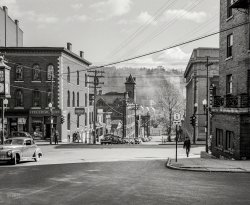
MAY CONTAIN NUTS

Search Shorpy
SHORPY ART

Framed or unframed, desk size to sofa size, printed by us in Arizona and Alabama since 2007. Explore now.
Join and Share
Ad-Free Shorpy
Shorpy is funded by you. Patreon contributors get an ad-free experience.
Learn more.

Recent comments
- Party of Eight?
- Good choice
- Recent view
- Hudson’s Big Store
- Say what??
- Grapes?!
- Just a Great photograph.
- A Beautiful Moment
- Such joy
- Bethune-Cookman University today
- Yellow sky at morning
- Side Winder
- Air Quality?
- Sojourner Truth riot
- None were so blind(ed)
- The less famous sister
- Good ol' days?
- Rise and Fall
- Goo Goo Ga Joob
- Ticket Retention
- Not the only one
- Vagaries of War
- Killed by Amtrak
- Back to the Future
- Wanted --
- If you can't stand the light
- Centralized Traffic Control, I believe
- What's really happening
- Heckuva remote control!
- Sometimes — Things Go Bump!
Member Photos
The Shorpy
Print Emporium
Print Emporium
Search Shorpy
Search results -- 30 results per page
- Native Fishers: 1941
- ... This right is now being contested in lawsuits." Medium format acetate negative by Russell Lee for the Farm Security Administration. ... place, but she's got her eye on something. Or someone.
Medium format I always wonder what size the negative is when it is 2x3 or 3 ... Posted by Dave - 02/05/2022 - 12:23pm -
![Native Fishers: 1941 September 1941. "Indians fishing for salmon at Celilo Falls, Oregon. At the present time Indians have by treaty exclusive right for fishing in Columbia River, which is adjacent to their reservation. This right is now being contested in lawsuits." Medium format acetate negative by Russell Lee for the Farm Security Administration. View full size.
About that footbridgeMy guess is that the Indians constructed it for the use of the folks contesting their exclusive right to fish.
No MoreSadly, these beautiful falls are now long gone; drowned by the building of the Dalles Dam.
A river runs through itThat’s a fantastic photo, just a hive of activity, with an exciting waterway and a dramatic backdrop. I see a fish in the big net on the right, and I think I see a guy up to his waist in the water, just left of the very center of the picture. Myself, I would feel somewhat precarious on those platforms, but no one has invited me along.
I think I see my manThe demurely-coifed lady in heels and hosiery and practical coat is certainly out of place, but she's got her eye on something. Or someone.
Medium formatI always wonder what size the negative is when it is 2x3 or 3 1/4x4 1/4 it would be interesting to know.
[4x3. - Dave]
What a Coincidence!Today I was driving West on I-84, along The Columbia River. I saw a sign for Celilo Falls. I looked out at the bloated river behind the Dalles dam. I wondered what the falls looked before inundation. I get to the hotel, eat a meal, and check my email. And I see this photo. First, I thought, what a great coincidence. But soon I was sad at the loss of a way of life and sustenance for the indigenous population.
Re: NativeI’m 63 and live in Canada, and the official word for Indigenous people has evolved over my lifetime, as follows: Indian, Native, Aboriginal, First Nations, Indigenous. (In French in Quebec it’s autochtone, “from the earth.”) I wonder what it will be next.
35 second newsreel footageEmbedded in the following Wikipedia entry is a 35 second newsreel footage of this very scene, taken in 1956.
https://en.wikipedia.org/wiki/Celilo_Falls
(The Gallery, Landscapes, Native Americans, Russell Lee)](https://www.shorpy.com/files/images/SHORPY-8c22358a.thumbnail.jpg)
- Manhattan Limited: 1943
- ... out of Union Station on the 'Manhattan Limited' run." Medium format acetate negative by Jack Delano for the Office of War Information. ... Posted by Dave - 05/07/2024 - 4:53pm -
![Manhattan Limited: 1943 February 1943. "Chicago, Illinois. One of the Pennsylvania Railroad's giant '6100' class [T1 prototype] engines pulling out of Union Station on the 'Manhattan Limited' run." Medium format acetate negative by Jack Delano for the Office of War Information. View full size.
Back to the FutureThe T1 may](https://www.shorpy.com/files/images/SHORPY-8d13137u.thumbnail.jpg)
- The Woman in the Window: 1943
- ... tower who operates block signals for railroad crossing." Medium format acetate negative by John Vachon for the Office of War Information. ... Posted by Dave - 04/16/2024 - 11:25pm -
![The Woman in the Window: 1943 May 1943. "Beaumont, Texas. Wartime occupational replacement by women in men's traditional jobs. Lady in signal tower who operates block signals for railroad crossing." Medium format acetate negative by John Vachon for the Office of War Information. View full size.
Just add window boxesTwo fallen flags --
MEC Maine Central: The Pine Tree Route
T&NO Texas & New Orleans: a subsidiary of the Southern Pacific Railroad
Whether it's a tower to control trains or highway gates, it is well-built, airy, and in need of some flower boxes to complement this sturdy structure
I wonderif the lady managed to get his attention. He seems to be engrossed on his phone?
NOT An Easy JobThis is not an easy job.
In my young days before I came to the USA, I was a conductor Guard on British Railways (as it was known then). Part of the training was to observe the signalman in the signal box (as they were called back then), and to see how that job functioned.
The strength needed to pull those levers was tantamount to doing the job correctly.
Kudos to that lady for doing that job.
You kids drive me nuts!She's clearly yelling at the brakeman to stay off his dang smartphone while he's working
WWII -- Replacing men with women at the railroad crossing.Postwar world -- Replacing both with automatic machinery.
Just a Year Too SoonThe film noir "Woman in the Window" premiered in 1944 with an innocent Clark Kent-like Edward G. Robinson becoming involved with a beguiling woman and a murder.
Texas Flyer wantedIs there a a ladder hidden behind the signal box, or is that what we're seeing on the leg in the foreground? (If so, it looks rather difficult to climb). But regardless, this appears to be a position where getting to work is the hardest part.
[There's also a ladder on top of the signal box. - Dave]
Indeed, but I believe she'd have a hard time reaching it.
She's leaningOut to get a better look at the shoe store on the other side of the tracks. Never know, there might be a good sale on TRAINers.
Casement windowsTrue industrial type with metal lace-like light frame, suitable for the warmer climate, that I am especially fond of. Contemporary architecture with "industrial windows" employed but with frames thick as an elephant's leg is completely missing the point.
Daddy! That's MY Daddy!Reminds me of a video I saw where the train engineer (& father) would take the time to lean out & deliberately wave as he passed his home each day. Seeing his delighted toddler son exclaim "Daddy! That's MY Daddy!" while being held in his laughing mother's arms warms the heart.
Clear Heads Choose ...A "Happy Blending"
(The Gallery, John Vachon, Railroads, WW2)](https://www.shorpy.com/files/images/SHORPY-8d19830a.thumbnail.jpg)
- Red Comb Feeds: 1943
- ... of the Harbor Belt's Blue Island Yard south of Chicago." Medium format acetate negative by Jack Delano for the Office of War Information. ... Posted by Dave - 04/13/2024 - 9:40pm -
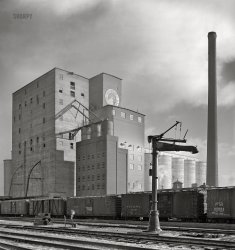
- The $64 Washer: 1941
- ... for sale. Sears Roebuck store at Syracuse, New York." Medium format negative by John Collier. View full size.
Mom Was Delighted I ... Posted by Dave - 03/02/2024 - 3:08pm -
![The $64 Washer: 1941 Its big 8-sheet porcelain tub is insulated to keep water warm! Streamlined 8-position wringer with soft balloon rolls has chromium pressure controls; push-pull safety release; roll-stop safety dry feed rest and automatic water-return board.
October 1941. "Kenmore washer for sale. Sears Roebuck store at Syracuse, New York." Medium format negative by John Collier. View full size.
Mom Was DelightedI remember my mother getting one like that circa 1950; primitive it may have been, but it beat the heck out of the tub and washboard it replaced.
Incidentally the price translates to $650 in current dollars. Not cheap, especially considering the lack of disposable income people had back then.
They've Gotten CheaperAlthough you can't buy that exact model these days, I think, a comparable washer, with electronics, would cost $1,031.47 in 2016 dollars.
$64 was a ton of money pre-WWII.
I remember my grandmother had one a bit earlier than that one. She used to roll it onto her front porch to wash clothes and drain the water onto her yard. I remember helping her when I was 3-4 years old and the wringer sucked my arm right into it. Sure glad she was close by and knew to hit the emergency release 'cause I remembered that pinch for a lot of years.
That was also when mom's (or grandmothers) used soap instead of detergent. It made great bubbles and smelled oh so nice!
Not Exactly CheapBut I'm sure that every part was Made in the U.S. A.
Familiar contraption!That looks a lot like the one that was in the basement of the house I shared in grad school at Duke in the early 80s. We were so broke, as students, we used that old thing and its wringer instead of going to a laundromat. If you have never gotten grabbed by an electric wringer, you can't fully appreciate that old saying about getting your teat caught in a wringer. YEOW!
Mom-in-Law Was Delighted, TooMy mother-in-law, who grew up as a Pennsylvania farm girl, used one of these until she moved out of her suburban Philadelphia house in 2002, aged 85. She'd run the clothes through the wringer and then put 'em in her fairly new automatic dryer. The grandkids were enthralled!
A Dream WasherWringer washers seem primitive now but they made life so much easier for women. I am old enough to remember my mother using one. In the photo above, you can see female customers in the background. They are all dressed up in hats, "good" coats, stockings and heels. Perhaps this Sears store was in downtown Syracuse. A trip downtown warranted getting dressed up.
I remember those machinesAlong with the two galvanized washtubs for rinsing the clothes. My job to fill them with water and the washer. Punch the hole in the bottle of bluing for the white clothes. Wipe the outside clotheslines off and if it was winter time shovel the snow out from under the lines. Clothes would freeze solid then we'd bring them back in and hang them up in the basement. Coal furnace would dry them in half and hour. Only on Mondays. Wash day.
Skip the Linepennsylvaniaproud said "if it was winter time shovel the snow out from under the [clothes]lines. Clothes would freeze solid then we'd bring them back in and hang them up in the basement. Coal furnace would dry them in half and hour."
Why not just hang them in the basement to dry in the first place (in winter)? Not getting why do the extra steps of outdoor clothesline.
Demonstration Washing MachineOn the extreme right, there is a washer with glass sides. These were used in department and appliance stores to demonstrate the washing action of the agitator. You could easily see how the clothes circulated in the water. When I left home in 1967 and moved into an old Vancouver, B.C. apartment building, the laundry featured three wringer washers with dual concrete laundry tubs for rinsing, a gas-fired ironing machine, and clotheslines in the spacious roof-top laundry room. Elderly ladies taught me how to use the machines - I was 19 at the time. In the United States, automatics outsold wringers as early as 1951, but in Canada that did not happen until 1968. One of the main reasons was that an automatic was three times more expensive than a wringer. I still have a 1944 Beatty wringer that I use occasionally. Here is a video on how to do your laundry with a wringer washer.
Looking at photos like thisWell... Europe was not only at war, but... twenty years late? This design, for me it's just like 1960 or something like that.
And some change...I'm sorry, but it's that 95 cents that broke the deal for me.
Remember the "Suds Saver" Feature?You would stopper one side of your dual basement sink (which was probably made of concrete) and the washer would drain the sudsy wash water into that side. Then with the next load, the washer would suck that wash water back in and reuse it. My mother would wash the whites or lights first and "suds save" to wash the kids' clothes after that. It certainly did save water, especially if you had a big family and washed lots of loads.
Old-style washers with wringerWhen my wife and I bought a 1920s Tampa bungalow, it had a wringer Maytag, originally fitted with a gas engine, in the garage building out back. Patty decided to use it one day, just for laughs, but she was astonished at how clean the clothes were.
Soon, that old Maytag was what she used all the time. If I remember correctly, Patty collected the water after washing and used that on her flowerbeds, and the soap helped control insects.
Regarding that wringer, yep; I caught my hand in it one time and that was all it took to teach me to stay clear of it after that.
But the old wringer washers worked and drying on a clothesline also had advantages.
At the cottageMy dad added a room to the back of my grandparents cottage the year after he added an electric pump for running water. He installed a flush toilet, and, a wringer washer just like the one in the picture appeared soon after. It was over in the corner, and I do not remember seeing it in use, but know that my grandmother would have used it to wash all the towels and such us ragamuffins got sand-encrusted at the beach.
She sure put up with a lot of noise from the succeeding groups of grand kids showing up week after week for their time at the cottage. It was a never-ending battle to keep sand out of the front room, and encouragments to 'Wipe Your Feet Outside'or 'Get the sand OFF' were made often and AUDIBLY. It didn't help. There seemed to always be a layer of sand in the bottom of the washer tub. Wonder if it wore out the gizzards.
Grandma's Washer of ChoiceAs a child growing up in the 60's, I remember well my grandmother owning two of these. She could afford a more modern style washer, but the wringer ones are what she preferred. I guess probably because that is what she was used to using. Sitting on her back porch, watching her feed those clothes through the wringers, looked like so much fun! As much as I'd beg her to let me do it she'd never let me for fear of getting my hand caught!!
(Technology, The Gallery, John Collier, Stores & Markets, Syracuse)](https://www.shorpy.com/files/images/SHORPY-8c33412a.thumbnail.jpg)
- Lonesome Highway: 1942
- ... 1942. "Deaf Smith County, Texas. Panhandle highway." Medium format acetate negative by John Vachon for the Office of War Information. ... Posted by Dave - 03/02/2024 - 11:53am -
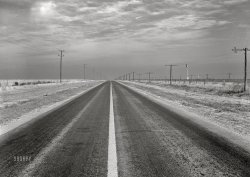
- John McCain: 1973
- ... Lt. Commander John S. McCain, Vietnam prisoner of war." Medium format negative by Thomas J. O'Halloran. View full size.
Richard Gere ... Posted by Dave - 06/02/2008 - 10:15am -
![John McCain: 1973 April 24, 1973. "Interview with Lt. Commander John S. McCain, Vietnam prisoner of war." Medium format negative by Thomas J. O'Halloran. View full size.
Richard GereAre you sure this isn't Richard Gere playing the part of a Navy Officer? He's done it before.
[Um, yes. We're sure. Next! - Dave]
Re: Richard GereHe actually looks more like Tom Cruise.
McCain Interview 1973Here's the 1973 McCain POW article for which this photo was taken. It was recently republished on USNews.com as a Campaign 2008 point of interest.
Time isHey, I came to see realy old pictures, not
2008-1973=35
35 years is old so you get a pass.
At least it's before color was invented.
There's a famous dude whos always in the news with the same name as this guy.
[So when was color invented? - Dave]
McCain InterviewThanks so much for posting the link to that amazing interview. I read the entire article, and found it fastenating, especially in today's context. I was young and in the Air Force during the Viet Nam era. I was stationed on Guam when Nixon ordered the bombing of Hanoi. Day and night the B-52s would roar down the runway headed for a round trip bombing run over Vietnam. During the ramped up bombing, I had visited with a B-52 pilot I knew earlier at one of my other stations, and he was very aware of what was at stake. Just as there is very much at stake in 2008. Will we repeat history, I wonder?
JMJohn McCain was more attractive in his younger days than one might imagine.
Mr McCainI guess he used to smoke. That's OK, so did I. I admire the man.
Film FormatDo you know, Dave, if this photo is cropped? It seems to be the right dimensions to have been shot on a 2x3 Century Graphic, or a later 6x9cm press camera - Graflex XL or Mamiya Press, say.
Sorry. I'm just a sucker for medium-format existing-light portraiture.
[Barely cropped. Full frame below. - Dave]
Young McCain.Wow! Impressive.
WowThis really is "The 100-Year-Old Photo Blog"!
McCain?Wow! This is almost eerie. He was quite a strapping young buck back in the day.
Young Buck Back In The DayWeren't we all.
(Politics, Public Figures)](https://www.shorpy.com/files/images/03413u.thumbnail.jpg)
- Checkin Tender: 1942
- ... on the road from a Chicago and North Western railyard." Medium format acetate negative by Jack Delano for the Office of War Information. ... Posted by Dave - 03/18/2024 - 10:36am -
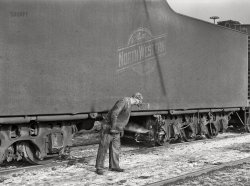
- Yosemite Cadillac: 1919
- ... Giant glass negatives make better pictures than smaller-format film. - Dave]
Medium- and large-format negs Churchkey, in the mid-to-late 1960s, we ... Posted by Dave - 06/09/2015 - 6:13pm -
![Yosemite Cadillac: 1919 The high Sierras circa 1919. "Cadillac touring car at Yosemite in snow." With the Sentinel Hotel in the background. 6½x8½ inch glass negative. View full size.
Sentinel Hotel"Near view of the three-story Sentinel Hotel, early 1920s, Yosemite Valley; with three autos parked along street, and valley cliffs in distance." From the San Joaquin Valley & Sierra Foothills Photo Heritage.
Artist Beautiful photograph. The talent of the photographer comes through and makes me all that more envious of what was accomplished when considering the materials and processes that they worked with back in the day.
[Those "materials and processes" are why the photo turned out so well. Giant glass negatives make better pictures than smaller-format film. - Dave]
Medium- and large-format negsChurchkey, in the mid-to-late 1960s, we couldn't use 35mm as it wasn't considered, at least by the folks who ran the newspaper I worked on, as a professional format.
I didn't care, as I loved my medium-format twin-lens relex Rolleis and Mamiya cameras. Plus, especially with large-format film like in the Speed Graphics, shooting ball games was much easier than with a 35mm. As long as you pointed in the right direction and tripped the shutter at the right time, the action was somewhere on that big neg. You just cropped tight and were a hero.
(The Gallery, Cars, Trucks, Buses, W. Stanley)](https://www.shorpy.com/files/images/SHORPY-337-01A.thumbnail.jpg)
- Hiawatha Noir: 1943
- ... it, the fastest steam engine in the world.
Hiawatha format What kind of film format do you think this is? Maybe medium format square?
[2¼-inch square nitrate negative. - Dave]
... Posted by Dave - 09/09/2011 - 6:54pm -
![Hiawatha Noir: 1943 Chicago, January 1943. "Chicago, Milwaukee, Saint Paul and Pacific 'Hiawatha' about to leave from Union Station." View full size. Photograph by Jack Delano.
HiawathaJust to let people know, that's the rear of the train, the last car known as an observation car. Also notice the raindrops falling through the roof ventilation, really neat photo.
[That's snow. - Dave]
A horny spotIt must've scared the bejeezus out of passengers looking out the rear window when they blew that air horn.
HiawathaJust so anybody doesn't think that this is a typical observation car, this was unique to The Milwaukee Road. They made these things themselves in their own shops in their home city. Most other railroads had "store bought" observation cars, either the open platform units familiar from the movies, or the cars typical of the streamliners where the car curves from the sides to the rear.
Front and BackThe locomotive on the Hiawatha was as much a thing of beauty as the "beaver tail" observation car. All designed by industrial designer Otto Kuhler. If this is the "Twin Cities Hiawatha" its 4-4-2 streamlined locomotive has been replaced with an E-6, itself a nice engine but nowhere near as lovely as those steam engines which were said to be the fasted ever produced in the United States (and some say, though without any records to prove it, the fastest steam engine in the world.
Hiawatha formatWhat kind of film format do you think this is? Maybe medium format square?
[2¼-inch square nitrate negative. - Dave]
(The Gallery, Chicago, Jack Delano, Railroads)](https://www.shorpy.com/files/images/3c30645u.thumbnail.jpg)
- Esso Extra: 1942
- ... 1942. "New York, New York. Girl at gasoline pump." Medium format acetate negative by Royden J. Dixon for the Office of War Information. ... Posted by Dave - 01/15/2024 - 11:46am -
![Esso Extra: 1942 December 1942. "New York, New York. Girl at gasoline pump." Medium format acetate negative by Royden J. Dixon for the Office of War Information. View full size.
Outfit materialVelour? Corduroy? It has a soft, plush look.
8 cents per gallon?Am I reading the price correctly on the gas pump?
[Um, no. - Dave]
Fill 'er Up!Tell me that's not Ethyl manning the pumps!
Neatness countsWomen employees had certainly improved the look of stations since John Vachon photographed one two years earlier.
The smoking sectionA fine example of modern looking "computer" pumps, at least if we ignore the archaic sight-glass (and those weird dome tops, that give them the appearance of small mosques).
What particularly caught my eye, however is the curious(ly skimpy) "No Smoking" signage: the placement gives the illusion that the proscription only applies to the regular grade
That is no girl!An adult woman, to my eye. But those were different days.
"Extra" pumpsWonder why there are two "extra" pumps sitting inside the station in the background apparently not (yet) in use. Maybe the station was in the process of converting over to the "new" style pumps and that's what motivated this photo.
[There are pumps on both sides of the island. What motivated the photo is wartime girl station attendants! - Dave]
Price per gallon todayAdjusted for inflation, 20 cents in 1942 would be $3.83 today.
Outfit material continuedI guessed it might be cotton velveteen?
Want to feel old?Few people who are less than solidly middle aged have seen gasoline pumps that show a sale's cost with only three digits. Yet before the 1973 oil embargo they were ubiquitous.
PeekabooI wonder who is that hiding behind the bulk oil dispenser? Doesn't appear to be wearing a pump jockey uniform.
When People Didn't Throw Away Pennies8 and 10 cents a gallon are $1.56 and $1.95 in today's dollars.
[The prices on these pumps are 18 and 20 cents a gallon. - Dave]
Mystery equipmentWhat is the equipment on the right in front of the two pumps and the person in black on the back side of the island?
Gas Is Less Expensive Today If 20 cents equals $3.83 today, one must remember that cars today get almost twice the mileage they got back then. So back then to go to and from the same distance as one would go today it would cost them 40 cents, adjusted for inflation should mean that gas today should be $7.66.
IMO, the reason we think gas prices are so high is because of all the "stuff" we simply must have that did not exist back then, like computers, cable TV, the Internet and more, that comes out of your paycheck each month. Take all that away and $3.50 a gallon would be less a drain today than 20 cents was back then.
In Case of Fire ... There is a handy soda-acid fire extinguisher hanging on the wall to the left. It appears that there was some wear and tear on the filler hoses dragging on the ground. The fix was to wind some heavy rubber tubing around the area on each hose. The Imperial Oil Company in Canada still uses the name Esso for its gas stations.
Silver LiningCoins were made from real silver back then! Take that into consideration when adjusting for inflation.
(The Gallery, Gas Stations, NYC)](https://www.shorpy.com/files/images/SHORPY-8d09847u.thumbnail.jpg)
- Carrier Mills: 1939
- ... prosperous mining region, suffering from the Depression." Medium format acetate negative by Arthur Rothstein for the Farm Security ... Posted by Dave - 02/04/2024 - 8:43pm -
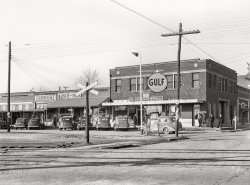
- Dark Matter: 1942
- ... 1942. "Sunray, Texas. Workers at a carbon black plant." Medium format acetate negative by John Vachon for the Office of War Information. ... Posted by Dave - 01/28/2024 - 3:02pm -
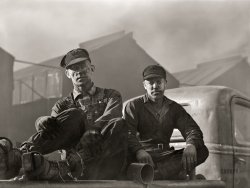
- Grand Hotels: 1942
- ... "Oklahoma City, Oklahoma -- Hotels on West Grand Avenue." Medium format acetate negative by John Vachon for the Office of War Information. ... Posted by Dave - 01/15/2024 - 12:00pm -
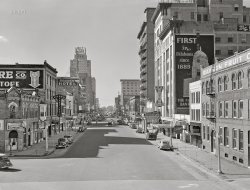
- The Newsroom: 1942
- ... composing room. Copy readers go up there to check proofs." Medium format acetate negative by Marjory Collins for the Office of War Information. ... Posted by Dave - 11/17/2023 - 11:09am -
![The Newsroom: 1942 September 3, 1942. "New York, New York. Newsroom of the New York Times newspaper. Right foreground, city editor. Two assistants, left foreground. City copy desk in middle ground, with foreign desk, to right; telegraph desk to left. Makeup desk in center back with spiral staircase leading to composing room. Copy readers go up there to check proofs." Medium format acetate negative by Marjory Collins for the Office of War Information. View full size.
The Front Page's Back RoomNot very glamourous, is it?? Even by the standards of the day, I would have expected something more impressive for the Paper of Record. But perhaps our expectations are tainted by modern conditions: whereas today the 'Times' may be NYC's only broadsheet, in 1942 there were a multitude - Journal-American, World-Telegram, the Sun -- some of which eclipsed the Times in circulation; but the real competitor for the quality reader was the Herald-Tribune. I've heard it posited that WWII is what earned the Times the final victory lap: it used its war-ration reduced pages to emphasize news, whereas the HT gave the edge to advertising. I don't know how true this is, but it's a great story.
Safe pre-OSHA WorkplaceLooks like way back then they didn't need an agency of the Federal Government to codify or remind them of the dangers of falling light globes (I didn't even know that was a thing.) Their safety conciousness even extended to the film used to record their workplace for posterity. Which begs the question, what happened to the guy at front left.
Paper cut? Malingerer? Bar fight?
Phones?I only see three telephones in that whole office! How can they get any work done?
I'm sure that everyone they would've needed to speak with was within shouting distance. Amazing how efficient things were back then!
No cubicle walls either.
Makeup desk???What, are they planning early for TV?
What a classic case of industrial chic, even with wire cages on the lamps!
Front Page Headlines September 4, 1942 New York TimesUS FIGHTS NEW LANDINGS IN SOLOMONS; SINKS CRUISER, 4 OTHER SHIPS IN PACIFIC; NAZIS ADVANCE NORTH OF STALINGRAD
Marines Meet Foe
Franco Shakes Up Cabinet, Ousts Suner and 2 Others
Allied Blows Force Rommel to Withdraw at Some Points
President Warns Youth to Choose Death or Freedom
Submarines Sink 5 Japanese Ships
Astor Real Estate Policy Shifted to Meet New Order
British Bombers Sear Karlsruhe; Sinclair Urges Sabotage in Reich
OPA to License All Meat Packers and Wholesalers in Control Move
The Copy Boywould take a writer's finished typing when the writer held it aloft saying a bit more than audibly, "BOY!" In later times this was changed to "KID!"
Got that from a WSJ veteran.
Why the cages around the lights?What do they need protection from?
SPIKE THAT STORY! NOT my hand!Copyboy! Get me OSHA! And having worked in such dangerous places in the 1960s ...
Light cagesWhy are there cages around the ceiling lights? All I could think of was that the composing room upstairs creates enough vibrations to occasionally knock a light fixture off its ceiling mount, and the cages protect those below.
Typewriters?Interesting. When I worked in a newsroom in the 70s it wasn't much different from this except everyone had a typewriter. I wonder why there's not a single one visible in this photo.
[You don’t need a typewriter to edit. Just a grease pencil. - Dave]
Not many visorsThis most be towards the end of the era for visors. Green eyeshades or dealer's visors are a type of visor that were worn most often from the late 19th century to the mid-20th century by accountants, telegraphers, copy editors, and others engaged in vision-intensive, detail-oriented occupations to lessen eye strain due to early incandescent lights and candles, which tended to be harsh (the classic banker's lamp had a green shade for similar reasons).
Wire mesh around the lights??What is that for. Oh, and that caricature, so not politically correct today.
Memo SpikeThat Assistant put his hand through the CE’s memo spike again.
Or maybe the editor is a very, very stern taskmaster.
Back in the day..Bill spikes, stick telephones, eye shades, rubber stamps, oak office chairs, pipe smokers.. all of an era.
Can anybody identify the round white things with the little handle sticking up?
[Gluepots. - Dave]
And the cages on the light fixtures — did things get rough in that room from time to time???
Times of ...Natural human data processing power.
Light Globe Cages?Not sure what the well thought out and professionally made wire cloth covers on the lights are all about. I guess it has something to do with being at war???
Grandpa, tell me 'bout the good old daysKind of depressing once you take it all in, a newsroom entirely staffed by men, plus the pipe smoking, the anti-Japanese propaganda poster, etc. It really is true that "The past is a different country. They do things differently there."
So many wonderful things to see from the old timesThe guy smoking a pipe, The candlestick telephones too. The wire cages on the light fixtures are also strange. Overkill, I would say. But it's a delightful photo of the past.
Shorpy logoIn an early comment below (“Safe pre-OSHA Workplace”), M2 writes, “Their safety consciousness even extended to the film used to record their workplace for posterity.” So I scrutinized the right edge of the photo, my head tilted down and to the right, to read: “EASTMAN—SAFETY—KODAK 101 SHORPY.” Very clever!
SaunaThese men don't need to go to a steam bath - it looks like their work place is already very hot and humid. Each of those caged ceiling lights is probably putting out 200 watts of heat, plus all the body heat of the men. Their shirts look very moist. The large metal ducts on the ceiling might only be for exhausting smoke and heat from the room rather than forced air conditioning. I would love the see a photo of the cord switchboard with operators connecting the candlestick telephones.
Not a coffee cup in sightCoffee rationing in effect already?
SwelteringThe high temperature in New York that day was 93 degrees -- no wonder they all look so sweaty.
Depressing? Why so Karen?Perhaps a history book is not in your future, or you'll be very very depressed. In other words. Lighten up.
Sweet Smell of the City DeskInhale deeply and let’s go back in time and take an olfactory tour of the newsroom. The first thing that hits you as you enter the room would be the tobacco smoke. I count at least three pipes and a cigarette, but no ashtrays. In a closed room the smoke and ash odor would be the first thing you notice. Weather archives report that the temperature reached 93 degrees F. in New York City on September 3, 1942 – near record heat. The next thing you’d notice would be man-sweat and hair tonic. Vitalis and Brylcreem and Murray’s Pomade each had a distinctive aroma and the miasma rising from those guys must have been remarkable.
Add to the vaporous atmosphere the smell of printer’s ink, gluepots, rubber-gum erasers, pencil shavings, leather satchels, and freshly developed photographs. Even though the clock says 9:20 AM perhaps you'd catch a whiff of flask-borne whiskey and, judging be the unshaven assistant city editor in the foreground, maybe the scent of monkey blood from his wound dressing. I’ll bet the gent in the eyeshade has a Limburger cheese and onion sandwich in a paper bag.
You can exhale now.
Goober Pea
Where's Hildy?This makes me want to watch "His Girl Friday".
Right off The Front PageThe movies from the 1930s led me to expect many more typewriters and whiskey bottles. Also, a sassy gal Friday.
Walk in their shoes"Nothing is more unfair than to judge the men of the past by the ideas of the present. Whatever may be said of morality, political wisdom is certainly ambulatory".
- Denys Arthur Winstanley
I'm with Al Bear I always love these photos of how things used to be in newsrooms, offices, labs, etc. and I'm especially intrigued by wartime home front photos. It's really easy for some to hold the past up to today's politically correct standards, but perhaps one of two of these newsmen lost a son or maybe even a daughter at Pearl Harbor or Midway. Maybe they have a son who recently landed at Guadalcanal. And perhaps there are women who are working in this environment but just happen to be out of the photo at the time. You don't know for sure, so don't judge.
And Now, The WeatherNOAA weather for Manhattan shows a high of 93 on 9/3/42. Might explain the matted hair, glistening foreheads and less than crisp work shirts.
The Hot SeatNew York in September, no A/C, everybody packed in like sardines ... no wonder everybody looks sweaty!
I too pictured a lot more typewriters.
9:20 am ... or pm?The previous shot of the wire service machines shows that it's pretty clearly dark outside (the left-hand window is open without whatever-it-is that's in the right hand window opening).
It seems to me that this is more likely the evening of September 3rd, 1942 rather than the morning.
[The Times is a morning paper, so yes, it's night. - Dave]
Norman Rockwell PhotographIf Rockwell was a photographer he'd have taken this image.
So full of action and detail. Those head visors, the not-paperless-office, the spiral staircase and all enveloped in that amazing masonry and concrete room.
Those paper spikes were dangerous, so sharp that a careless hand could easily get a nasty wound (another reader has picked up a suspicious wound). Never mind that the spike might just go through and destroy a very important word.
(The Gallery, Marjory Collins, NYC)](https://www.shorpy.com/files/images/SHORPY-8d08925a.thumbnail.jpg)
- Illinois Central: 1942
- ... Locomotives in an Illinois Central Railroad yard." Medium format acetate negative by Jack Delano for the Office of War Information. ... Posted by Dave - 01/31/2024 - 4:09pm -
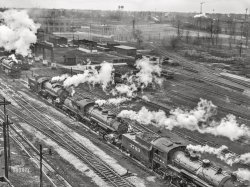
- War Kitchen: 1941
- ... Rogans pay about twenty percent of their income for rent." Medium format acetate negative by Alfred Palmer for the U.S. Office for Emergency ... Posted by Dave - 06/21/2022 - 10:31pm -
![War Kitchen: 1941 July 1941. "War housing. Mrs. B.J. Rogan and her small son, Bernie, in the kitchen of the Rogans' new war home at the Franklin Terrace housing project in Erie, Pennsylvania. Mr. Rogan is a drill press operator at a nearby plant which is working three shifts on war contracts. The Rogans pay about twenty percent of their income for rent." Medium format acetate negative by Alfred Palmer for the U.S. Office for Emergency Management. View full size.
Light bulb in the trash canThat used to be a familiar sight, as manufacturers held to highly inefficient--thus highly profitable--incandescent bulbs long after alternatives were possible. It took an act of Congress (Energy Independence and Security Act of 2007) to phase out incandescent bulbs that typically lasted 750-1000 hours, as opposed to today's LED bulbs which won't need replacing for 25,000 hours.
That CoffeepotWas my worst enemy after visiting my father-in-law's house for the first time for an overnight stay and being asked by my wife to "make coffee." Of course I had no idea how to make coffee in that kind of pot.
We had only been married a year and I had been in the US for the same.
Needless to say, I greeted everyone to breakfast with the best coffee sludge a newbie could make.
Still thereThe Franklin Terrace apartments are now called the John E. Horan Garden Apartments. The old kitchen was tiny but charming; now, not so much.
https://www.hace.org/housing-info/hace-rental-properties/john-e-horan-ga...
https://www.hace.org/about-us/revitalization/
Snack TimeIt's about 2 pm according to the clock on the wall. I am just wondering what he did to get a snack at 2 pm.
When I was his age, I didn't dare ask for a snack that soon after lunch. I usually waited until about 3 pm. Chances were 50/50. If if got to be 4 pm - it was too late - 'dinner is soon'.
There's a busted light bulb in the trash bin. I wonder what wattage it was.
Looks peaceful to meEverything spic and span and in its place while Mrs. Rogan whips up something tasty for her family, but I'm sure it reflects accurately on the home front during wartime. Those Servel gas refrigerators always seemed to produce a faint odor, but they did work using a science I never understood of how to make cool with a gas flame. Between 1955 and 1960 with I was in Boy Scouts, we'd spend Memorial Day weekend at a deer lease in the Hill Country of Texas between Kerrville and Medina. The first thing our Scoutmaster did upon entering the asbestos sided cabin was light the Servel refrigerator and that odor lingered throughout the weekend, but we had a lot of fun.
[Fun fact: Servel is a contraction of "Serving Electricity." - Dave]
Movin' on upIt's new, nice, clean, and not an attic nor a small travel trailer still on wheels.
I couldn't find the Rogan family in the 1940 Census, but did find this description of their living arrangement progress: "Defense housing, Erie, Pennsylvania. Mr. and Mrs. B. J. Rogan and their small son, Bernie, at home in the living room of their new defense home in Erie, Pennsylvania. Mr. Rogan is a drill press operator at the nearby General Electric Company plant. He earns $42.50 a week, and pays about twenty percent of his income for rent. Before moving into a newly constructed defense home at the Franklin Terrace housing project, he lived in a remodeled attic, and then a trailer. For the latter he paid 6 dollars a week, including all utilities."
I'm pretty sure the B. stands for Bernard. The Franklin Terrace housing project is now the John E. Horan Garden Apartments. Horan was/is the director of the Erie Housing Authority. These units are now public housing.
PercolatorI suggest Baxado ought to retry the percolator for making coffee. I still have my parents' percolator which is used extensively on camping trips. Makes a great cup of coffee, but be careful of the grounds!
Encyclopedias, The seat of knowledge
Loco ...... motive on the table.
1941, huh?Since The U.S. didn't enter the war until December, why was this family living in "war housing?"
[Yes, huh. Some googling might provide enlightenment. Keywords: Lend-Lease, Battle of Britain. - Dave]
Found 'em Bernard J. Rogan, Sr., wife Lenore, and son Bernard Jr. are in the 1940 census, living in Washington DC, where Bernard Sr. is an insurance agent. All 3 were born in Pennsylvania.
In 1948 they are living at 2130b Gladstone Ct., Erie PA. Occupation was listed as "Tool Rpr".
In 1950, they are back in Washington DC, where Senior is manager of a service station. Lenore works for the Federal Power Commission.
Senior died in about 1983. Lenore died in 1992. Junior died in 2016.
Let there be (free) light."Light bulb in the trash can" reminded me that here in Detroit (and I assume other cities) the Edison Co. would exchange light bulbs (burned out for new) at no charge. That went on for years until some local store owner sued Edison for restraint of trade because he wanted to sell more lightbulbs. And won! What a yutz.
Monday ... is laundry day. And this kitchen appears to have a combination kitchen sink and deep laundry tub. If Mrs. Rogan was lucky she would have an electric wringer washer, otherwise it would be the old washboard. It would lean against the angled portion of the laundry tub. My 1928 house still has its original double concrete laundry tubs.
There were also refrigerators that operated on kerosene.
Re: Snack Time by Soda_PopGiven his age, the social conventions of the time regarding raising children, etc., it's highly likely that Junior had a relatively early lunch - between 11:30 and noon, followed by a nap. Upon rising from said nap, he could have had a regular snack, followed by playtime in the yard all afternoon. Dad may have been at work until 3 or 3:30, and walked home by 4. Dinner may not have been until 5, so a 2 o'clock snack for Junior wouldn't have been out of place. Kids' stomachs are smaller than adults are, and their metabolism is generally higher.
(The Gallery, Alfred Palmer, Kids, Kitchens etc., WW2)](https://www.shorpy.com/files/images/SHORPY-8b00438u.thumbnail.jpg)
- Cat Patrol: 1942
- ... superintendent getting ready for a hunting trip." Medium format acetate negative by John Collier for the Office of War Information. ... Posted by Dave - 01/05/2024 - 5:37pm -
![Cat Patrol: 1942 November 1942. "Pittsburgh, Pennsylvania (vicinity). Montour No. 4 mine of the Pittsburgh Coal Company. Assistant superintendent getting ready for a hunting trip." Medium format acetate negative by John Collier for the Office of War Information. View full size.
Yes pleaseLike fanhead, I'm all about that fabulous chair. What a work of art. The kitty ain't bad either but I prefer tuxedo cats.
Fair dealI would trade the shotgun for that gorgeous chair. And I'll throw in the cat.
Great trainerI would prefer to take a dog.
A hammer double.Heirloom material.
Having that talk with his cat.https://www.barnesandnoble.com/w/how-to-talk-to-your-cat-about-gun-safet...
Hunting catsWhen the cat, Mary Ann, currently sleeping at my side was younger, she and her sister would accompany me when I would go out on our property deer hunting. One evening, I was sitting on a log and noticed the cat sitting in front of me was staring and her ears were pointed. I raised my rifle and spotted a buck about 40 yards away. At the shot, the deer ran and Mary Ann ran after it. It went into a thicket of briars and I had to work my way in. When I got there, Mary Ann was sitting on the deer's neck, swatting and biting its ears. As good a tracker as she was, I was never able to train her to retrieve.
Shotgun from the PastLooks like a very old E. Remington & Sons 12 Gauge.
[He's also packing a Mouser. - Dave]
The vibeof 1600's Dutch painting.
"Lifter"As subsailor says it's probably a Remington shotgun, a "lifter" design like the Remington-Whitmore. It looks like cleaning and oiling time (which I'm not sure I'd do in such nice clothes)
Shoots & FleasTeaching a cat to use a shotgun can lead to nothing but trouble.
Montour No. 4!I used to live over the hill from that mine and its mining town, known both as Lawrence and Hill's Station, which is likely where this picture was taken. The mine ran under my house is a leafy Pittsburgh suburb, and operated until it was flooded by a breakthrough from the adjacent, closed Montour #10. The rail line that swung like an arc south of Pittsburgh connecting the Pittsburgh Consolidation Coal Company's mines is now a popular rail trail.
(The Gallery, Cats, John Collier, Pittsburgh)](https://www.shorpy.com/files/images/SHORPY-8d09543a.thumbnail.jpg)
- PneuTube: 1942
- ... and other communications are quickly sent in this way." Medium format acetate negative by Jack Delano for the Office of War Information. ... Posted by Dave - 01/05/2024 - 3:13pm -
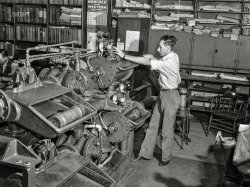
- I.C.R.R.: 1942
- ... Illinois. Locomotives in the Illinois Central railyard." Medium format acetate negative by Jack Delano for the Office of War Information. ... Posted by Dave - 01/16/2024 - 4:47pm -
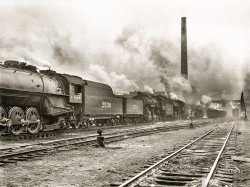
- 535-07-5248 and Wife
- ... would make him 27 years old when this picture was taken.) Medium format safety negative by Dorothea Lange. View full size .
Wow, and is ... Posted by Dave - 08/01/2020 - 3:52pm -
![535-07-5248 and Wife Oregon, August 1939. "Unemployed lumber worker goes with his wife to the bean harvest. Note Social Security number tattooed on his arm." (And now a bit of Shorpy scholarship / detective work. A public records search shows that 535-07-5248 belonged to one Thomas Cave, born July 1912, died in 1980 in Portland. Which would make him 27 years old when this picture was taken.) Medium format safety negative by Dorothea Lange. View full size.
Wow, and is she hot.Wow. She's kind of hot too. Well, I am not showing proper respect for history either.
Wow. He's kind of hot.Wow. He's kind of hot. I am really not showing the proper respect for history.
She'sno slouch either as long as you're on the subject. I'm loving this series of Dust Bowl era pics. I have known a few people who back then had their number on their arm upside down so they could read it.
Relative?He's my brother's namesake, which makes me wonder if we're related. Can you get more information from Social Security numbers, other than name and d.o.b./d.o.d.? I'm Australian, so I don't know anything about the system.
[The dates and place of death (Portland, Oregon) are the only information given. - Dave]
Hey- Even grandpas were sexyHey- Even grandpas were sexy in their day!
SSDIYou can search the Social Security Death Index (available at Ancestry.com, among other places) and it will tell you dob/dod plus last residence. You can also generate the form to send to the Social Security office to request (purchase) a copy of the original application which will give a little more information.
I'm impressed with how well groomed they both are. Sure he's got stains on his trousers, but his hair is combed and (except for the mustache) he is clean-shaven. In the background, his wife is wearing what looks like a fairly stylish dress and her pose looks like it could have come out of a fashion magazine. They certainly do not look like the tired and downtrodden people we've seen in other pictures. Makes me wonder what he did before and how long they've been following the harvest.
[He was, as the caption says, a lumber worker. - Dave]
Pierce Brosnan?He bears an uncanny resemblance to Pierce Brosnan when he as in The Matador. Or, I guess I should say, Pierce Brosnan bears an uncanny resemblance to him.
See for yourself:
http://tinyurl.com/2gga3j
They managedThey managed to keep clean and she looked pretty good
They're both veryThey're both very attractive! The Depression was tough, even for the good-lookin'..
:)
Hubba!What a babe! :)
There are just so manyThere are just so many awesome things about this photo. The elegant beauty of the woman. The handsome man with pipe. The tattoo on the arm with his Social Security number of all things. Then to be able to search them out by using his social and modern technology. It's just a treat!
Thomas CaveTHOMAS CAVE
born: 02 Jul 1912
death: Jun 1980
last residence: Portland, Multnomah, OR
535-07-5248
Oregon Death Index
Name: Thomas Urs Cave
Spouse: Annie
Birth: 1912
Death: dd mm 1980 - Multnomah
U.S. World War II Army Enlistment Records, 1938-1946
Name: Thomas U Cave
Birth: 1912
Military: 29 Oct 1942 - Portland, Oregon
Residence: Oregon, Multnomah, Oregon
U.S. Veterans Gravesites
Name: Cave, Thomas U Thomas U Cave
Birth: 2 Jul 1912
Death: 4 Jun 1980
Military: 12 Nov 1942
Military: 4 Feb 1946
Pierce Brosnan?I think he looks more like a younger Treat Williams.
www.movievillains.com/images/xanderdrax.jpg
Well now, he's obviously aWell now, he's obviously a Dapper Dan man!
A treat, indeed!
Wish weA treat, indeed!
Wish we could interview this couple now and ask them about those times.
I'll bet they'd say it wasn't such a bad time of their lives.
They had each other...
Perhaps we people have forgotten what's really important in life.
SmokeIt was a inexpensive pleasure back then
Harder TimesTimes were harder back then, and arguably so were the people. I'm struck by how much older than I he looks as we are both the same age.
Makes me wonder if he had a great head start on life experiences at 27, and I'm lazily slow-poking my way through life. Maybe I should just count myself blessed to live in such times of relative ease and prosperity.
Actually, it probably has more to do with the fact that he could actually grow facial hair at this point in his life...but I think I'm going to stick with the "harder times" thesis : )
Or more smoke?Maybe it was all the smoking those people did that aged them? Imagine being flat broke, having to live under a tarp, and still spending money on tobacco!
Social Security Number? PricelessNot thrilled that so much is revealed with a SSN search. Somebody is probably getting a credit card in his name right about now.
Re: Harder TimesI think that it was a product of responsibility. People back then were given greater responsibility at a much younger age and had a lot more expectations back then.
SSNI asked the Library of Congress to upload the .tiff file so we could read his SSN. It could be a 9, not a 4. The LOC librarian took out the original negative but could not be sure either. I agree, Thomas Cave makes more sense because the other option, Clarence Horn, was born in 1917. That man does not look 22. But, often writing history comes down to this kind of reasoning and, hopefully, corroboration.
Unfortunately, Thomas Cave's 1942 enlistment document lists him as "divorced, with dependents." That might not be accurate for a whole host of reasons, especially he does not show up on the 1930 Federal Census. I'd like to believe she was the "Annie" listed as his spouse on his death certificate. History doesn't kill romance; it just makes sure it's true.
Tobacco was a standard ration in the Depression. Do note the date of death, however. He died at 67. That said, there is no dress rehearsal for life. Times were tough, in a way we can only begin to imagine today. Scurvy: can you give me lists of those tatooed numbers or maybe let me interview you about the people you knew?
If anyone wants to know more about the conditions in which this man and woman lived during the Depression, please do not hesitate to ask. I am teaching the photo tomorrow and am introducing my students to the kind of enterprising research and insight I've seen reflected in this list. Bravo. (And yes, he's hot--my students agree).
Dr. Kate Sampsell-Willmann
Assistant Professor of American History and Photographic Historian
Georgetown University
School of Foreign Service in Qatar
ksw29@georgetown.edu
Re: SSNThe TIFF is already on the LOC site for anyone to download. Here's the number in question. 535-07-5248. Maybe you are not using the highest resolution file available. (There are two.)
LookalikesUnfortunately I don't have a picture to prove it, but he looks like my brother in law at that age. Rich is Greek and Irish. I wonder what nationality Thomas Cave was.
[His nationality was American. Ethnicity? - Dave]
SSN numberHi Dave:
As a professor of history, the LOC uploaded the highest res photo on my request. The LOC librarian examined the neg with a magnifying glass and could get no greater detail. Unfortunately, writing a 9 with an exaggerated bottom hook was common handwriting practice in the '30s (as it in in Western Europe today). Also, the tattoo was not doen with a gun. A 4 with an open top would have been easier to do than a curved 9. If it is indeed a 4, the tattooist made the job harder on himself by closing the top of the 4. If you notice, the straight lines in the 3 and 7 are more distinct than the curved lines. Quite honestly, it looks like my Dad's handwriting (1924-1991, US Army 1942-1946). In some ways, we cannot believe our eyes when looking at old pictures. We have to see them in their historical context.
Also, the the letters are SSA not SSN. They stand for Social Security Administration. SSN did not become a common acronym until after World War II. The first SSNs were issued in 1935, a year before this picture. The New Deal agencies were referred to back then as "the alphabet agencies" and then "alphabet soup." For example, Lange, a photographer working for the RA, had previously worked for FERA (forerunner of today's FEMA) and later the FSA, took the picture under the auspices of the USDA. Before the New Deal, government was much smaller, and, saving the USDA, these "alphabetics" (as they were also called) did not exist. There were dozens.
For a great read on the Depression (that assumes no prior knowledge of the era), I recommend Robert McElvaine, _The Great Depression: America, 1929-1941_.
We have to take all the facts, inside and outside the image, before making sound historical conclusions. But, engaging in ths kind of dialogue is the best way to learn more of our history. I hope that looking at these amazing artifacts of our national past sparks a greater interest in the history, one that is not dependent on memorization of dates and names (which I hate too). History is about feelings and motivations and all manner of human endeavor. Thanks for the opportunity to discuss this picture with you.
BTW, if anyone thinks he is an ancestor (his middle name was Urs), is the names "Urs" a common name in your family? I think it might be German. Giving a mother's maiden name as a middle name, or the first name of a parent or grandparent, was common practice in the early 20th c. Because "Urs" is textspeak for "yours," I can't do too much with a quick Google search.
Best,
Kate
Dangling modifiersTouché. I wish my students picked up such things.
Kate
[Imagine a fact-checking school of piranhas and you basically have our readership. (Kidding!) - Dave]
The Trap of the Dangling Modifier>> As a professor of history, the LOC uploaded the highest res photo
The LOC is a professor of history? Hmm.
UrsThe name “Urs” is common in Switzerland, but not in Austria or Germany. Only the female equivalent, Ursula, is quite common here.
SmokingMy father once told me that he started smoking during the Depression because it killed his appetite. You know how some folks worry that if they quit smoking they'll gain weight. He smoked so there would be more food for his brothers and sisters. Unfortunately he like his father and several of his uncles, brothers and sister fell victim to emphysema
re: Lookalikes-DaveThanks Dave, that's what I was trying to say. Mind goes blank ever so often and I use the first word I can think of. Old age and drugs are he-- on a mind.
Urs, smoking, and identityI think Urs is also an old Celtic name. I still don't get why he doesn't show up in the 1930 census. Anyone on the list in Multnomah, Oregon? He's buried at Willamette National Cemetery in Portland: Col-2, Row 382, Site B. Maybe they have a next of kin on record to whom the picture can be shown? His 1980 death cert. lists an Annie as spouse, but his enlistment record lists him as divorced with dependents. Don't know if the woman is Annie (before they got married) or the former Mrs. Cave. Every generation thinks it invented premarital sex and cohabitation. In the 1920s and 1930s, it was pretty common in all strata of society. Sometimes in the Depression, the especially hard-hit would not bother to get a formal divorce; people would just leave.
He also might have been a Wobbly. 1935 is kind of late, but they were always strongest in the West: mining and timber.
Another thing bothers me about his "identity": Thomas Cave's enlistment record has him at 5'6" and 156 pounds. I know there are ways to judge height of sitting people with software, but that's beyond me at the moment.
My father used to cup his cigarettes in his hand until he quit in the 1980s, "so the snipers couldn't get a fix." That's why it's "unlucky" to light 3 cigarettes with one flame, so says my Vietnam Vet husband. Remember the old WWII movies, "smoke-em if you got-em, boys." I think I also remember my Dad saying something about the tobacco killing hunger in the Depression. Dad was a tenant farmer 'til he went off to war. Pregnant women were encouraged to smoke to stop morning sickness. Tobacco use was ubiquitous. The Red Cross even handed out cigarettes in the 1931 drought.
Best,
Kate
re: to Kate Urs, smoking, and identityThanks for the info Kate. Maybe he and the woman in the picture weren't really married. Interesting, and I agree about the "premarital sex and cohabitation". I couldn't believe my ears when I finally was told the stories about my family ;o)
My dad used to do that with his cigarettes too. He never said why however, but now I know :)
TattooYou mention that you don't think the tattoo was put on with a machine. As a tattooer for 17 years I can pretty much assure you that it was. That kind of serif style and the continuity of size would be impossible for a novice to achieve using a hand-poke method.
Thomas CaveThomas Cave, 1912-1980.
Kind of WeirdThis is one of my favorite pictures I've seen here on Shorpy. For some reason, these two make me think of Rooster and Lily from "Annie."
Looking Back to NowThere are some historic photographs -- and they are rare indeed -- that somehow manage to look as if they were shot in the present, just yesterday. This is one such. I'm not speaking of the people exactly but the manner in which they enter the camera. Not all of Dorothea Lange's (or other commercial photographers of any era) manage to convey such "magic" but this one does. It took my breath away when I first saw it (elsewhere) last month.
A handsome rakeNot sure if this fits the bill, but I'd nominate this pic for the Handsome Rakes gallery. I'll bet people walked up to him and told him he looked like Errol Flynn. His girl is on the pretty side as well, though I think we have pictures aplenty in the pretty girls gallery!
Movie star looksHe reminds me of Errol Flynn. Maybe it's the mustache?
Two more photos of Thomas CaveTwo more of Lange's photos of Thomas Cave (neither quite so interesting visually as the one here) came up via the LOC's "Neighboring Call Numbers" browser: LC-USF34-020536-E and LC-USF34-020538-E. In the second of these, Cave appears to be deliberately displaying his Social Security number tattoo. Perhaps he was a true believer in the promises that it represented. Other photos from this group of 30 identify the bean harvest locale as "Oregon, Marion County, near West Stayton."
"Cute Boys"?We have "Bathing Girls!" and "Pretty Girls" categories; when, oh when, will "Cute Boys!" be created? Along with Mr. Cave, "Powerhouse Mechanic and Steam Pump" should be included! Yowza is it getting warm in here?
[Look at the tags above the photo. The category you're describing already exists. - Dave]
Bean Pickers, Marion County, OregonMy father's family left Oklahoma in 1934 headed for California, and by 1939 would have been permanently settled in Marion County, still picking other people's crops and working odd jobs. None of my family from my father's generation, or the one before his, is still alive, but it does make me wonder if they might have encountered this handsome couple back then.
First Generation LifelockMr Cave's efforts to protect himself against identity theft were, perhaps, not so well thought out.
PragmaticI think he is a pragmatic man, his circumstances make it quite possible that he will be found dead at the side of the road or in a ditch. The number on his arm makes identification possible.
Mofred InfoHere he is, with three wives, on FamilySearch:
Tillman Thomas Ursel Cave 2 July 1912 – 4 June 1980
https://www.familysearch.org/tree/person/details/GQL8-S8Z
A little bit more about Thomas U. CaveAll this information was found via the newspaper archive at genealogybank.com. (I would have just posted links to save space, but it is a paid site.)
In the June 4, 1949 issue of The Oregonian, there is a birth announcement that Mr. and Mrs. Thomas U. Cave gave birth to a daughter on May 28. Then, on Sept. 22, 1950, another announcement that another daughter (Juanita L.) was born on Sept. 13. An address is included in both announcements.
Then, a tragic story from the May 4, 1952 issue: "Kelso Grid Star Dies in Collision". It reads:
KELSO, Wash. May 3 (AP) - Richard "Rip" Raappana, 24, well-known southwest Washington athlete, was killed early Saturday. His automobile swerved into a Consolidated Freightways truck and trailer a mile north of here on the Pacific Highway, the state patrol reported.
Louise N. Robinson, 21, Longview, a passenger in his car, was injured critically.
The state patrol said the truck driver was Thomas U. Cave, 39, of Portland.
Raappana was an all-round athlete at Kelso high. He played college football for Eastern Washington college at Cheney and last fall was with the University of Hawaii in Honolulu.
No Golds Gym HereWhat impresses me most is that his nice body is most likely due to heavy labor, not lifting weights in a gym.
LooksHe looks like David Gandy, one of the top male models of the last 10 years
We know him as 535-07-5248But his wife just called him "5". I think she's got kind of the Dorothy Lamour vibe:
Who knew History could be so HandsomeI love checking out Shorpy everyday, and it's a double pleasure when such a handsome picture pops up.
Service DetailsThe grave marker said he was a Sgt during WWII. One of the lucky ones to have made it to the end after enlisting in 1942. Does anyone have the ability to look up his service record? Would love to know what he did and where he was during WWII.
Reminds me of Freddie MercuryBritish musician, singer and songwriter, best known as the lead vocalist and lyricist of the rock band Queen.
Late to the game, but --I have a little more information about this man, if anyone is interested.
Anyone looking on a genealogy/records site might have some trouble finding him under the name Thomas Urs Cave, because it looks like his real name was Tillman Thomas Urs Cave.
I initially found a census record for a Thomas U Cave in 1940. At the time he was renting a house in Shasta, Oregon, and stated that he was a truck driver who had an eighth grade education. He was also married - but not to Annie (Ann Kathryn per the grave marker?). His wife was a woman named Vivian, who was a fruit picker on a farm. I believe Vivian is the lady in the photograph.
But that was it, beyond the service records/SSA death record already posted about. But a census record for 1920 caught my eye because the young boy, Tilman T Cave, had a sister called Juanita - the same name Thomas gave his daughter in 1949 per the newspaper announcement. In 1920 Tilman and Juanita lived with their parents, Tilman B and Sarah N Cave, on a farm in Buckham, Oregon. A possible match, but not 100% guaranteed.
Searches for the name Tilman Cave, though, found three good records:
- a 1918 WWI draft registration for a Tillman Benjamin Cave, wife Sadie, both living in Buckham, Oregon
- a 1930 census record for Benjamin T and Sadie N Cave in Los Angeles, California
- a 1940 census record for Benjamin T and Sadie N Cave in Portland, Oregon
I realize the names change during this time. I've known plenty of people who go by their middle name, which would account for Tillman Benjamin becoming Benjamin T, and it's possible that Sadie is a pet name for Sarah given the shared middle initial of 'N'. As for the sudden jump from Oregon to LA and back, I'm guessing a lot of people migrated for possible work.
The clincher record: a 1934 marriage record of a Tillman T.U. Cave to a Vivian Couture (both residents of Multnomah County, Oregon) in Washington State. The witnesses' signatures are Benjamin Cave and Saddie [sic] Cave.
Unfortunately I still can't find Tillman or Thomas Cave in the 1930 census, but we're at the mercy of both the census-takers and transcribers here. I've found faults from both before (a prime example: the census of 1940 says Vivian worked as a picker on a Fruit Farm, but it has been transcribed in the index as a Kunt Farm. I don't even want to imagine what one of those would be.) He's probably out there somewhere.
All of this isn't 100% proof, but that's hard to get without a chain of vital records.
If any of the previous posters are still reading this, or new readers comes across this, I hope you find this information of interest!
Relationship dynamicsHer place on the photo, uncomfortable body language and wary eyes as if the photographer was an attractive woman.
My Great-GrandmaI loved reading all the comments. Yes, this is a picture of my great-grandma Vivian. My grandmother recounted the story to me. A photographer came into camp and because of this, no one was allowed to go work while the photographer went tent to tent taking pictures. Hence the death stare she was giving. They lost out on an entire day’s wages because this guy wanted to take their picture. And yes, my grandma remembers it as a man who came even though it is credited to Dorothea Lange. I know very little of the man in the picture. I do however know that my grandma is not resting in peace next to him. What I remember of Grandma Vivian is how her house was in the middle of the woods and she had a pet deer that would visit her daily and she would let it in the house. She had the most beautiful flowers around her property. And she always wore a head scarf. She died when I as around 3 years old.
My Cooper cousinTillman Thomas Cave was my cousin, he was married at least twice. Vivian Couture (pictured), I have some photos of her and she worked for Kaiser Mills in Portland, Oregon. She had a photo ID indicating she was 5'9", Tillman was 5'6". She was a slender dark haired dark eyed girl and her half brother Melvin was lighter haired with very blue eyes. Tillman's full name is Tillman Thomas Ursel Cave, born July 2, 1912, died June 4, 1980. He married Vivian on July 3, 1934. They were together seven to nine years. He later married Ann Kathryn Bloom. His name Cave had been shortened from Cavendish at some point.
(The Gallery, Dorothea Lange, Great Depression, Handsome Rakes)](https://www.shorpy.com/files/images/8b15572u.thumbnail.jpg)
- Apolitical Animal: 1942
- ... "Bismarck, North Dakota. State capitol." Yea or neigh? Medium format acetate negative by John Vachon for the Farm Security Administration. ... Posted by Dave - 01/07/2024 - 12:12pm -
![Apolitical Animal: 1942 February 1942. "Bismarck, North Dakota. State capitol." Yea or neigh? Medium format acetate negative by John Vachon for the Farm Security Administration. View full size.
That would be a yeaYes, that is the state capitol in Bismarck. Below is from another angle, as seen by me in December 1989. In both photos, it was freezing.
I did not encounter a friendly horse on my visit. Instead, I found myself in the mean-ass stare of a buffalo, made of rebar. On the capitol grounds is also a memorial to veterans of all wars. There is a hole in the roof, placed so that at 11am on November 11th, a ray of sun shines upon the bronze globe. And, very similar to the Vietnam Wall in D. C., the names of those who gave their lives, right up next to you, grouped together in way too many conflicts. Very thoughtful and impressive.
"The ayes have it".According to my heads-up count.
Deco SchmeckoThat ugly building is supposedly Art Deco in style but it looks like Brutalism to me. Wish I could unsee it.
Tom SwiftyShelby Foote introduces politics in General Lee calling for his horse Traveller to be brought: "Orderly! Orderly!" he called hoarsely, not seeing Tucker close by with Traveller, whose bit had been slipped to let him graze.
[I had a pony named Hoarsely. - Dave]
Human affairsI think the horse’s opinion on human politics can be found behind his left rear leg.
At Twenty One StoriesThe capitol building was completed in 1935, and still is the tallest occupied building in the state.
Is this circa 1963 Bulgaria?All that's missing is the typical giant mosaic of Lenin leading the way for the apparatchiks and peasants.
Still on the fence?I like this post!
(The Gallery, Horses, John Vachon, Landscapes, Politics)](https://www.shorpy.com/files/images/SHORPY-8c21278a.thumbnail.jpg)
- Engine of Change: 1942
- ... switching engine is being rebuilt for use on the road." Medium format acetate negative by Jack Delano for the Office of War Information. ... Posted by Dave - 01/08/2024 - 7:29pm -
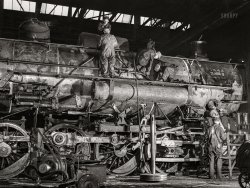
- Oil Train: 1942
- ... for the Pennsylvania Rail Road to be sent on to the East." Medium format acetate negative by Jack Delano for the Office of War Information. ... Posted by Dave - 01/09/2024 - 3:05pm -
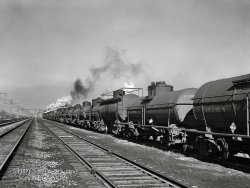
- Junk, Food: 1942
- ... Montana. Eating lunch at the scrap salvage campaign." Medium format acetate negative by Russell Lee for the Office of War Information. ... Posted by Dave - 01/07/2024 - 12:15pm -
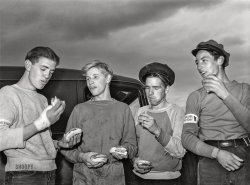
- Wartime Washington: 1942
- ... East Front. Sentry posted outside of House chamber." Medium format acetate negative, Office of War Information. View full size.
... Posted by Dave - 01/07/2024 - 12:07pm -
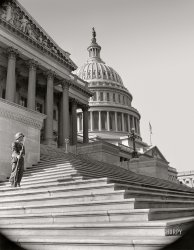
- Picnic Munch: 1942
- ... "Hayti, Missouri. Cotton Carnival picnic. Boy eating." Medium format acetate negative by Arthur Rothstein for the Office of War Information. ... Posted by Dave - 08/21/2023 - 2:08pm -
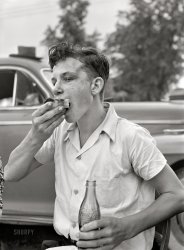
- Get Me Rewrite: 1942
- ... gets the story on the phone from reporter outside." Medium format acetate negative by Marjory Collins for the Office of War Information. ... Posted by Dave - 11/22/2023 - 11:10am -
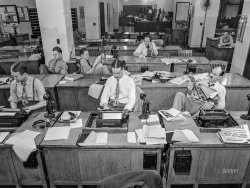
- Yard Cop: 1942
- ... railroad guard inspecting an oil tank car in the yards." Medium format acetate negative by John Vachon for the Office of War Information. ... Posted by Dave - 12/04/2023 - 11:27am -
![Yard Cop: 1942 October 1942. "Tulsa, Oklahoma. Mid-Continent Petroleum Corp. refinery, Tulsa station of the Great Lakes pipeline. Armed railroad guard inspecting an oil tank car in the yards." Medium format acetate negative by John Vachon for the Office of War Information. View full size.
The trusty WinchesterI've seen pictures of the yard cop with a night stick. Winchester is the baseball bat. I guess for the war effort and saboteurs?
Changing job focusA few years earlier the railroad yard cop would have been after hobos; movies of the 1930s have many such scenes. By 1942, war and economic activity had largely solved the hobo 'problem'. Now the concerns were sabotage, theft of raw materials, and security in general.
The Case of the Missing Journal LidSomeone obviously pilfered it! The oil-filled journal box should have a snug-fitting cover, as seen on the one at far left, to keep rain water and road dust out of the bearing area. The journal box closest to the gun-toting lawman seems to have taken its leave?
Black and White HeatA rifle ... next to an oil tank(er)??? Guess he didn't see the movie (But he had a good excuse: it wouldn't be released until seven years later)
Vintage graffiti?I hadn't thought about graffiti in 1942. But then why not. Much less ugly than spray paint!
[Those are yard-crew markings. - Dave]
How StylishIn a three-piece suit & tie complete with handkerchief, this fellow seems quite overdressed. Railyards (especially in the days of steam locomotives) were very dirty places. Bib overalls would have been more appropriate. Maybe he spends time in an office or just wanted to look good for Mr. Vachon's camera.
(The Gallery, John Vachon, Railroads)](https://www.shorpy.com/files/images/SHORPY-8d44981a.thumbnail.jpg)
- Little Falls: 1941
- ... Falls, New York." Which is at least a two-stoplight town. Medium format negative by John Collier. View full size.
The Bank is still ... Posted by Dave - 12/05/2023 - 3:42pm -
